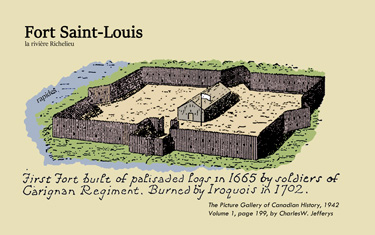Bernard Deniger dit Sansoucy.

Military Service.
Bernard Deniger dit Sansoucy joined Pierre-André de Froment's company of le Régiment de Carignan-Salières. Like many in the military he had chosen a dit name (an alias used by soldiers); his was Sansoucy which means "care-free". Bernard boarded le Vieux (or Joyeux) Siméon, a two hundred ton Dutch merchant ship chartered to transport the Chambly, Froment, La Tour and Petit companies to the colony. His shipmate included our ancestor Louis Badaillac dit La Plante, also part of Froment's company. They left the French port of La Rochelle 19 April 1665 and were at sea 61 days before arriving in ville de Québec. Their numbers increased the population of the small village by 25%.
They were sent to help defend New France from Iroquois invaders. But one of their number, Pierre Couc dit Lafleur, was a victim of friendly fire in August when he was struck by lead launched from a catapult. In October the Froment company relocated to Trois-Rivières where they spent the winter.
Among their first order of business was the construction of a string of forts along la rivière Richelieu. The waterway connected le fleuve Saint-Laurent to Lakes Champlain and George, and with portage, the Hudson and Mohawk Rivers - and thus was a well-used path for enemies of the French and their Huron allies. The men were tasked with building Fort Saint-Louis at the Bassin de Chambly near the rapids.  The wood fort built by the soldiers in 1665 was under the direction of le Capitaine Jacques de Chambly. The palisades were 15 feet high though they barely withstood the wind that came with storms in the area. The fort was equipped with 3 canons and trebuchets which lobbed rocks at the attackers.
The wood fort built by the soldiers in 1665 was under the direction of le Capitaine Jacques de Chambly. The palisades were 15 feet high though they barely withstood the wind that came with storms in the area. The fort was equipped with 3 canons and trebuchets which lobbed rocks at the attackers.
Adding the force of soldiers had the desired effect on tamping down attacks, and it was not long before the regiment was retasked. The men were given the option of remaining in New France with enticements such as land and wives. Adherence to Catholicism was all but required to settle however, so Bernard (and our ancestor Louis Badaillac) reaffirmed his faith at his confirmation at the Chambly fort on 20 May 1669. At this time he indicated he was born in Bordeaux, Guyenne in southern France on the Atlantic coast. This was around 1627.
Marriage and Family.
The marriage record has been lost, but it is believed he wed Marguerite Raisin about 1670. (Some have set the date as 22 November 1671; the date the couple’s first child, Jean, was born in Chambly.) She was a fille du roi, that is, she was sponsored by King Louis XIV, who covered her dowry and that of other young women who would move to the colony. She arrived 31 July 1670 aboard La Nouvelle-France along with our ancestors Georgette Richer and Anne Lagou. Without the marriage record, little is known about her origins.
Sieur de Chambly offered concessions of land in October 1673, Deniger received his on the 14th. Just north of Chambly, it was bounded on the south by the Huron River (a tributary of the Richelieu River). The land measured two arpents (about 384 feet) on the waterfront by 40 arpents. His neighbor to the north was Jean Péladeau. Styling the lots long and narrow afforded each settler access to the river, the main transportation hub.
Our ancestor Pierre was born 17 October 1677 in Chambly, but did not get baptized until the 20th of January the following year. A few months later, 20 July 1678, Deniger obtained a new land concession in "de terre Chambly".
The 1681 census at Contrecœur Ste-Trinité Fort St-Louis lists his family just below that of Charles Robert dit des Lauriers. A fellow soldier, he was the first husband of our ancestor Marie LeBer. Bernard de Nigé was 54, Marguerite Raisin, 30. In their household were their 5 children Jean, 11, Jean-Baptiste 9 ans, Marie, 6, Marguerite 4, and our ancestor Pierre, 2 years. Bernard owned a fusil (a type of musket), had 4 bêtes à carnes (literally horned beasts) and 8 arpents of his land was cultivated.
It is known that Marguerite Raisin was 49 when she passed on 21 November 1700 and was buried at La Prairie four days later. Bernard Deniger had died about a decade earlier, after the birth of his son René on 17 April 1684 and before the marriage of his daughter Marie ten years later on 16 August 1694.
- Jetté, René, Dictionnaire généalogique des familles du Quebec des origines à 1730 (Montréal: Les Presses de l'Université de Montréal, 1983)
- Dictionnaire généalogique des familles Canadiennes depuis la Fondation de la Colonie Jusqu'a Nos Jours, Tanguay, L'Abbé Cyprien, Baltimore: Genealogical Publishing Company, 1967
- https://commons.wikimedia.org/wiki/Category:Rolle_des_Soldats_du_Regiment_de_Carignan_Sali%C3%A8re_qui_se_sont_faits_habitans_de_Canada_en_1668), originally taken from champlain2004.org
- 1681 census at Contrecœur Ste-Trinité // Ft St Louis (p61)
- Searching Through Old Records… p60 August 6th (1665) The burial of [Pierre] Cuoc dit Lafleur, 41, one of M. de Froment's soldiers, who married Marie Mite8ameg8k8e in Trois-Riviéres. He had been shot accidently by one of his companions. "Occusus glande catapultae fortuito â socio" / "Killed with a lead projectile catapulted by an ally"
- Notes Archeologiques; Le Fort de Chambly; 1709 a 1760; p1-3
- Faillon - Vie de la sœur Bourgeoys, fondatrice de la Congrégation de Notre-Dame de Villemarie en Canada, suivie de l'histoire de cet institut jusqu'à ce jour, Tome I, 1853 (illustrion p 206).png
- https://www.migrations.fr/
- www.geocities.com/~carignan/09_Nav_Carignan/E9nav_car.html
- Jefferys, Charles W. 1942; The Picture Gallery of Canadian History Volume 1, p.199: Fort Chambly; Library and Archives Canada, No. 1972-26-756
